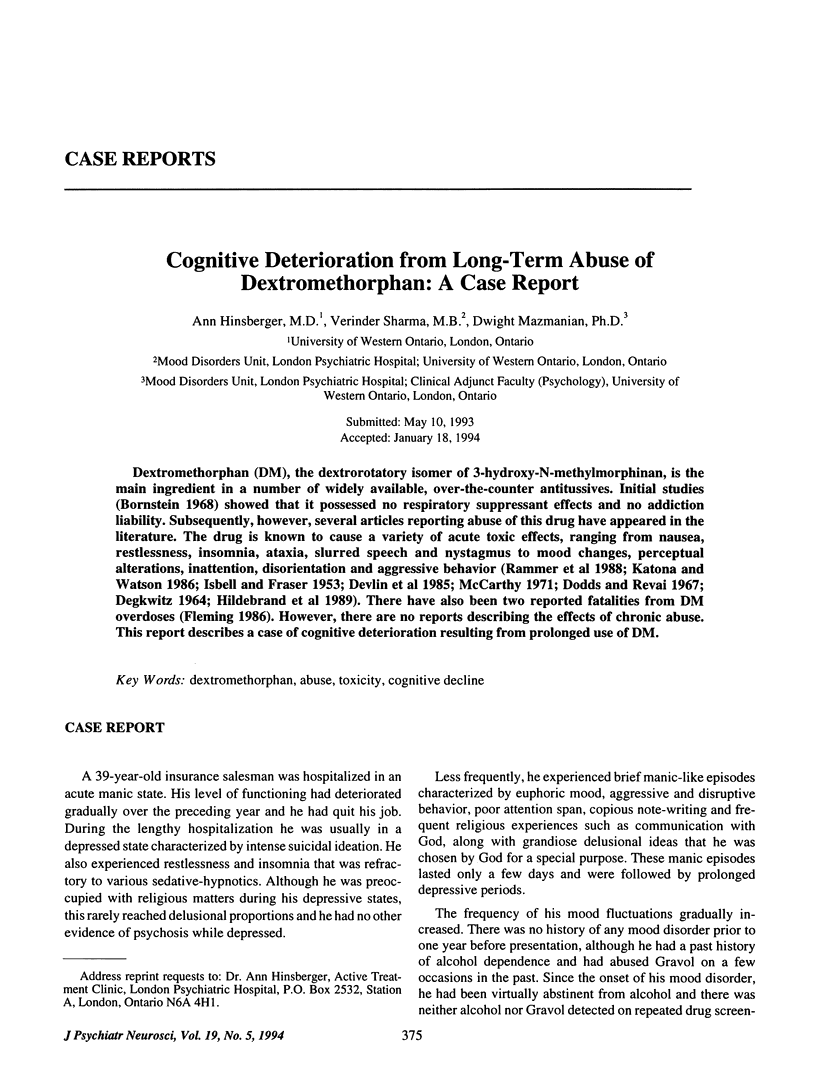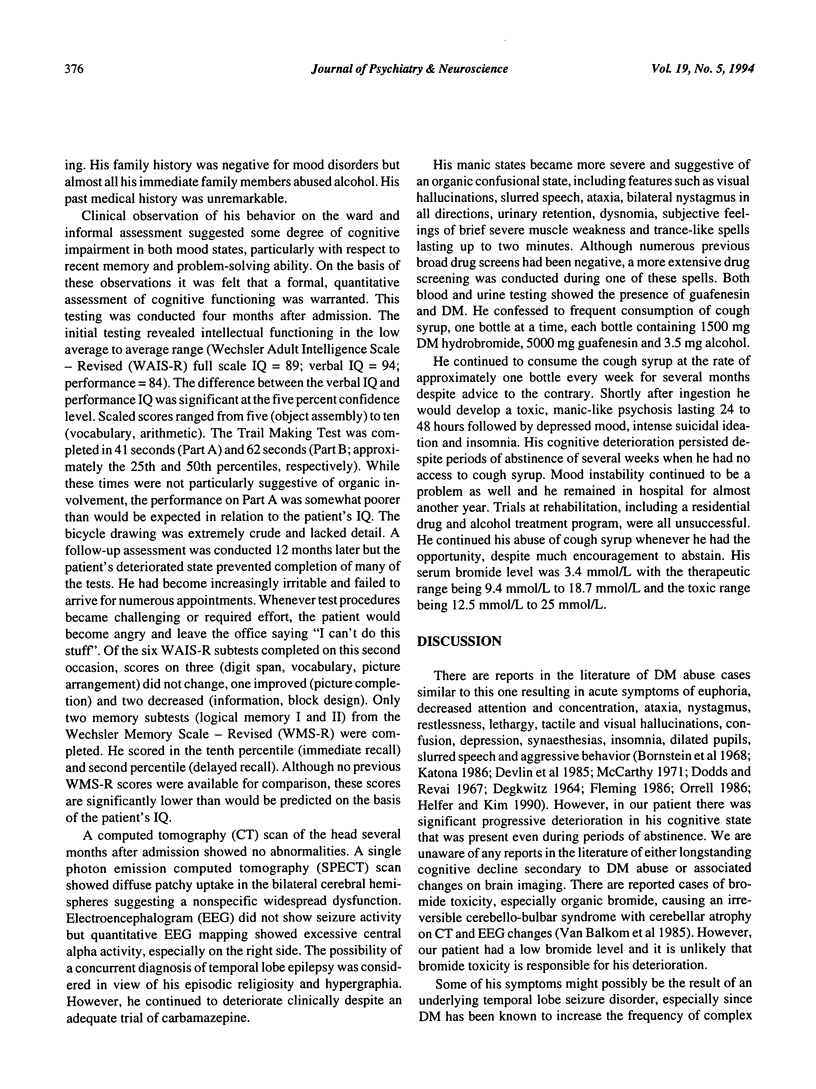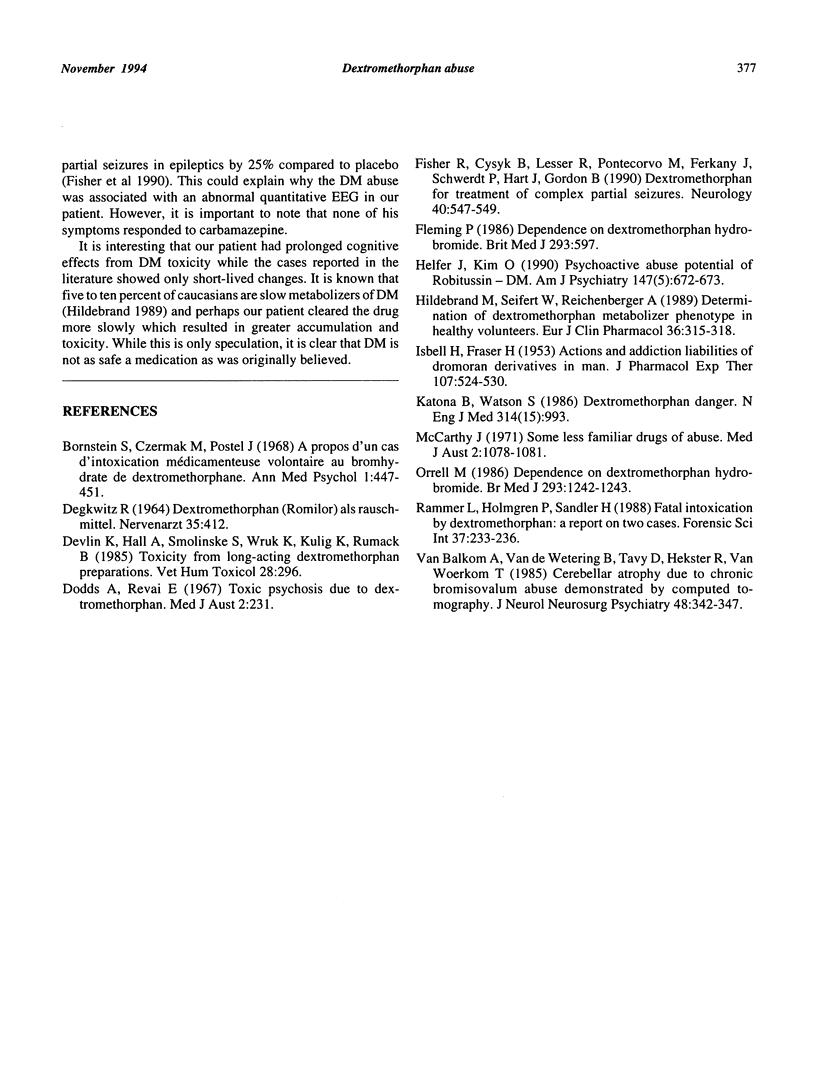Abstract
Dextromethorphan (DM), the dextrorotatory isomer of 3-hydroxy-N-methylmorphinan, is the main ingredient in a number of widely available, over-the-counter antitussives. Initial studies (Bornstein 1968) showed that it possessed no respiratory suppressant effects and no addiction liability. Subsequently, however, several articles reporting abuse of this drug have appeared in the literature. The drug is known to cause a variety of acute toxic effects, ranging from nausea, restlessness, insomnia, ataxia, slurred speech and nystagmus to mood changes, perceptual alterations, inattention, disorientation and aggressive behavior (Rammer et al 1988; Katona and Watson 1986; Isbell and Fraser 1953; Devlin et al 1985; McCarthy 1971; Dodds and Revai 1967; Degkwitz 1964; Hildebrand et al 1989). There have also been two reported fatalities from DM overdoses (Fleming 1986). However, there are no reports describing the effects of chronic abuse. This report describes a case of cognitive deterioration resulting from prolonged use of DM.
Full text
PDF


Selected References
These references are in PubMed. This may not be the complete list of references from this article.
- Bornstein S., Czermak M., Postel J. A propos d'un cas d'intoxication médicamenteuse volontaire au bromhydrate de dextrométhorphané. Ann Med Psychol (Paris) 1968 Mar;1(3):447–451. [PubMed] [Google Scholar]
- DEGKWITZ R. DEXTROMETHORPHAN (ROMILAR) ALS RAUSCHMITTEL. Nervenarzt. 1964 Sep;35:412–414. [PubMed] [Google Scholar]
- Fisher R. S., Cysyk B. J., Lesser R. P., Pontecorvo M. J., Ferkany J. T., Schwerdt P. R., Hart J., Gordon B. Dextromethorphan for treatment of complex partial seizures. Neurology. 1990 Mar;40(3 Pt 1):547–549. doi: 10.1212/wnl.40.3_part_1.547. [DOI] [PubMed] [Google Scholar]
- Fleming P. M. Dependence on dextromethorphan hydrobromide. Br Med J (Clin Res Ed) 1986 Sep 6;293(6547):597–597. doi: 10.1136/bmj.293.6547.597. [DOI] [PMC free article] [PubMed] [Google Scholar]
- Helfer J., Kim O. M. Psychoactive abuse potential of Robitussin-DM. Am J Psychiatry. 1990 May;147(5):672–673. doi: 10.1176/ajp.147.5.672b. [DOI] [PubMed] [Google Scholar]
- Hildebrand M., Seifert W., Reichenberger A. Determination of dextromethorphan metabolizer phenotype in healthy volunteers. Eur J Clin Pharmacol. 1989;36(3):315–318. doi: 10.1007/BF00558166. [DOI] [PubMed] [Google Scholar]
- ISBELL H., FRASER H. F. Actions and addiction liabilities of dromoran derivatives in man. J Pharmacol Exp Ther. 1953 Apr;107(4):524–530. [PubMed] [Google Scholar]
- Katona B., Wason S. Dextromethorphan danger. N Engl J Med. 1986 Apr 10;314(15):993–993. doi: 10.1056/NEJM198604103141517. [DOI] [PubMed] [Google Scholar]
- McCarthy J. P. Some less familiar drugs of abuse. Med J Aust. 1971 Nov 20;2(21):1078–1081. [PubMed] [Google Scholar]
- Rammer L., Holmgren P., Sandler H. Fatal intoxication by dextromethorphan: a report on two cases. Forensic Sci Int. 1988 Jun;37(4):233–236. doi: 10.1016/0379-0738(88)90230-7. [DOI] [PubMed] [Google Scholar]
- Van Balkom A. J., Van de Wetering B. J., Tavy D. L., Hekster R. E., van Woerkom T. C. Cerebellar atrophy due to chronic bromisovalum abuse demonstrated by computed tomography. J Neurol Neurosurg Psychiatry. 1985 Apr;48(4):342–347. doi: 10.1136/jnnp.48.4.342. [DOI] [PMC free article] [PubMed] [Google Scholar]


